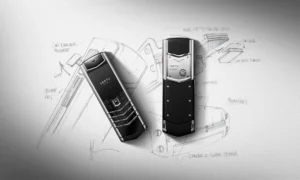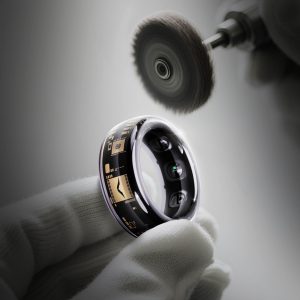Struggling to keep track of your wellness goals in our fast-paced world? Discover how the latest smartwatches are revolutionizing personal health management.
What You'll Learn:
- The core functionalities and benefits of health-focused smartwatches.
- A straightforward guide to setting up and starting your health tracking journey.
- Essential best practices and expert advice for maximizing your smartwatch's potential.
- Advanced techniques to leverage your device for deeper health insights.
What is Smartwatch For Health?
Understanding Smartwatch For Health
A smartwatch for health is a wearable device designed to monitor, track, and analyze various physiological and lifestyle metrics. Unlike traditional smartwatches that focus primarily on connectivity and notifications, health-focused models integrate advanced sensors and sophisticated software to provide comprehensive insights into your well-being. These devices act as personal health companions, empowering users to make informed decisions about their lifestyle and fitness routines. They go beyond simple step counting, offering features like heart rate monitoring, blood oxygen levels (SpO2), ECG capabilities, sleep tracking, stress management, and even fall detection.
Key Benefits and Features
The advantages of incorporating a health smartwatch into your daily life are numerous. They offer convenience and constant monitoring, allowing you to stay aware of your health status throughout the day and night.
Here are some key benefits and features:
- Activity Tracking: Accurately monitors steps, distance, calories burned, and active minutes.
- Heart Health: Real-time heart rate monitoring, resting heart rate, and alerts for unusually high or low rates. Some models offer ECG (Electrocardiogram) for detailed heart rhythm analysis.
- Sleep Tracking: Analyzes sleep stages (light, deep, REM), duration, and quality, providing personalized insights for improvement.
- Blood Oxygen (SpO2) Monitoring: Measures the oxygen saturation in your blood, a key indicator of respiratory and overall health.
- Stress Management: Tracks stress levels based on heart rate variability and offers guided breathing exercises.
- Workout Modes: Dedicated tracking for various sports and activities, providing specific metrics for each.
- GPS Tracking: For accurate mapping and distance tracking during outdoor activities.
- Hydration and Movement Reminders: Prompts to drink water or move if you've been sedentary for too long.
- Women's Health Tracking: Features for menstrual cycle tracking and symptom logging.
“The ability to see my sleep patterns and understand how my daily activity affects my recovery has been a game-changer for my training.” – Sarah K., Fitness Enthusiast
To illustrate the differences, let's compare common features across different smartwatch categories:
| Feature | Basic Smartwatch | Health-Focused Smartwatch | Advanced Health Smartwatch |
| Step Tracking | Yes | Yes | Yes |
| Heart Rate | Basic | Continuous | Continuous, HRV |
| Sleep Tracking | Basic | Detailed Stages | Detailed Stages, Score |
| SpO2 Monitoring | No | On-Demand/Background | Continuous/On-Demand |
| ECG | No | Available on select models | Available on select models |
| GPS | No | Yes | Yes |
| Stress Tracking | No | Yes | Yes, with guided exercises |
| Workout Modes | Few | Many | Extensive, auto-detection |
How to Get Started with Smartwatch For Health
Prerequisites and Requirements
Before diving into the world of health smartwatches, ensure you have the necessary components and information.
- Compatible Smartphone: Most smartwatches require a smartphone (iOS or Android) to sync data, receive notifications, and access advanced features through a dedicated app. Check the smartwatch's compatibility requirements.
- Bluetooth Connectivity: Ensure your smartphone has Bluetooth enabled.
- Wi-Fi Connection: For initial setup, software updates, and syncing larger data sets, a stable Wi-Fi connection on your smartphone is often beneficial.
- App Installation: Download the manufacturer's companion app from your smartphone's app store.
- Personal Information: Be prepared to provide basic information like age, gender, height, and weight for more accurate calorie and metric calculations.
Step-by-Step Setup Process
Setting up your new health smartwatch is typically straightforward. Follow these general steps:
- Charge Your Smartwatch: Ensure your smartwatch is fully charged before the initial setup.
- Download the Companion App: Search for the official app associated with your smartwatch brand (e.g., Fitbit, Garmin Connect, Apple Health, Samsung Health) and install it on your smartphone.
- Create or Log In to Your Account: Open the app and either create a new user account or log in if you already have one.
- Pair Your Smartwatch:
- Turn on your smartwatch.
- Open the companion app and select the option to add a new device.
- Follow the on-screen instructions to discover and pair your smartwatch via Bluetooth. You might need to enter a code displayed on the watch.
- Grant Permissions: The app will likely ask for permissions to access your location, Bluetooth, and other necessary data. Grant these for full functionality.
- Complete Profile Setup: Enter your personal details (age, gender, weight, height) and set your initial health goals.
- Sync Data: Allow the app to sync data from your smartwatch. This may take a few minutes.
- Explore Features: Familiarize yourself with the app interface and the various health metrics and settings available on your smartwatch.
Tip: Some smartwatches offer an on-wrist setup process, guiding you through pairing and basic configurations directly on the device.
Best Practices for Smartwatch For Health
Industry Standards
Adhering to industry best practices ensures you get the most accurate data and a seamless experience.
- Consistent Wear: For optimal tracking, wear your smartwatch consistently, especially during sleep and exercise.
- Proper Fit: Ensure the watch sits snugly but comfortably on your wrist. A loose fit can affect sensor accuracy, particularly for heart rate and SpO2.
- Regular Syncing: Sync your data to the companion app regularly to back up your progress and analyze trends over time.
- Software Updates: Keep your smartwatch and its companion app updated to the latest versions to benefit from new features, bug fixes, and improved accuracy.
- Sensor Cleaning: Clean the sensors on the back of the watch periodically with a soft, dry cloth to ensure they function optimally.
Expert Recommendations
Health professionals and fitness experts offer valuable insights for maximizing your smartwatch's health benefits.
- Focus on Trends, Not Just Numbers: Don't obsess over daily fluctuations. Instead, look for long-term trends in your activity, sleep, and heart rate to understand your body's patterns.
- Use Data for Action: The data is only useful if it leads to positive changes. If your sleep score is consistently low, use the insights to adjust your bedtime routine.
- Combine with Other Health Practices: A smartwatch is a tool, not a magic bullet. It should complement a balanced diet, regular exercise, and adequate rest.
- Listen to Your Body: While smartwatches provide data, always pay attention to how you feel. If you experience unusual symptoms, consult a healthcare professional, regardless of what your watch reports.
- Personalize Your Goals: Set realistic and achievable goals within the app. Gradually increase your activity or improve sleep hygiene based on your current capabilities.
“Your smartwatch can be a powerful motivator, but it's crucial to interpret the data within the context of your overall well-being and consult with a doctor for any health concerns.” – Dr. Emily Carter, Sports Physician
Let's look at how different health metrics can be interpreted:
| Metric | What it Measures | How to Improve |
| Resting HR | Heartbeats per minute when at rest. Lower is better. | Regular aerobic exercise, stress reduction, adequate sleep. |
| Heart Rate Variability (HRV) | Variation in time between heartbeats. Higher is better. | Good sleep, stress management, consistent exercise, avoiding alcohol. |
| Sleep Score | Overall sleep quality based on duration and stages. | Consistent sleep schedule, dark/cool bedroom, limit screen time before bed. |
| SpO2 | Oxygen saturation in blood. Normal range is 95-100%. | Good respiratory health, avoid smoking, stay hydrated. Consult doctor if consistently low. |
| Steps | Daily physical activity. | Incorporate more walking, take stairs, set daily step goals. |
Advanced Smartwatch For Health Techniques
Professional Tips
For users who want to go beyond the basics, several advanced techniques can unlock deeper health insights.
- HRV Training: Use Heart Rate Variability (HRV) data to gauge your body's recovery status and readiness for intense training. A higher HRV generally indicates better recovery.
- VO2 Max Estimation: Many advanced smartwatches estimate your VO2 Max, a measure of your cardiorespiratory fitness. Track this over time to see improvements from your workouts.
- Sleep Stage Analysis: Delve into the specifics of your sleep cycles (light, deep, REM) provided by your watch. Identify patterns that might be affecting your daytime energy levels.
- Stress Score Interpretation: Understand the factors that contribute to your stress score. Use the watch's guided breathing or mindfulness features when your stress levels are high.
- Customizing Data Fields: For specific workouts, customize the data screens on your watch to display the most relevant metrics (e.g., pace, heart rate zones, elevation).
Advanced Strategies
Leveraging your smartwatch for more complex health management requires a proactive approach.
- Data Export and Analysis: Some companion apps allow you to export your data (e.g., CSV files). You can then use spreadsheet software or specialized health analysis tools for deeper dives.
- Integration with Other Apps/Devices: Connect your smartwatch data with other health and fitness apps (like MyFitnessPal for nutrition) or smart scales for a more holistic view.
- Physiological Trend Monitoring: Track long-term trends in metrics like resting heart rate, resting SpO2, and sleep patterns. Significant deviations could be early indicators of illness or overtraining.
- Using ECG for Irregular Heartbeat Detection: If your watch has ECG capabilities, learn how to perform an ECG reading when you feel symptoms of an irregular heartbeat, and share the results with your doctor.
- Biofeedback Training: Some advanced smartwatches offer biofeedback exercises, where you can see your physiological responses in real-time to learn how to regulate them.
“I use my smartwatch's HRV data to decide whether to push hard in a workout or opt for active recovery. It’s made my training much more efficient.” – John R., Marathon Runner
Here's a comparison of advanced features:
| Feature | Description | Benefit |
| VO2 Max | Estimated maximal oxygen uptake during exercise. | Gauges cardiorespiratory fitness; helps track training effectiveness. |
| HRV Status | Assesses your body's recovery state based on heart rate variability. | Helps optimize training intensity and prevent overtraining. |
| Advanced Sleep Stages | Breaks down sleep into Light, Deep, and REM sleep cycles. | Identifies sleep quality issues and aids in improving sleep hygiene. |
| Body Battery | A metric that estimates your energy levels based on sleep, activity, and stress. | Helps manage energy throughout the day and plan activities. |
| Blood Pressure Monitoring (Emerging) | Some newer devices are beginning to offer cuffless blood pressure estimation. | Provides an additional vital sign for cardiovascular health monitoring (accuracy varies). |
FAQ (Frequently Asked Questions)
Q: How accurate are smartwatches for health tracking?
A: Modern smartwatches offer impressive accuracy for many metrics like step counting and heart rate. However, accuracy can vary between brands and specific sensors. Metrics like SpO2 and ECG are generally considered supplemental and not a replacement for medical-grade devices. Always consult your doctor for medical concerns.
Q: Can I use a health smartwatch without a smartphone?
A: While most smartwatches can track basic activities like steps and heart rate without a connected phone, you'll need a smartphone to sync data, view detailed analysis, receive notifications, and access most advanced features and settings.
Q: How often should I sync my smartwatch data?
A: It's recommended to sync your smartwatch data daily or at least every few days. This ensures you don't lose any tracked information and allows you to monitor your progress consistently.
Conclusion
The 2025 health smartwatch landscape offers unprecedented opportunities to take control of your well-being. By understanding their core functionalities, setting them up correctly, and adopting best practices, you can transform these devices into powerful allies for a healthier lifestyle. Whether you're a fitness enthusiast or simply aiming for better daily habits, leveraging the advanced features and insights available can lead to significant improvements.
Ready to take the next step in your health journey? Explore the latest health smartwatches and start tracking your progress today!








